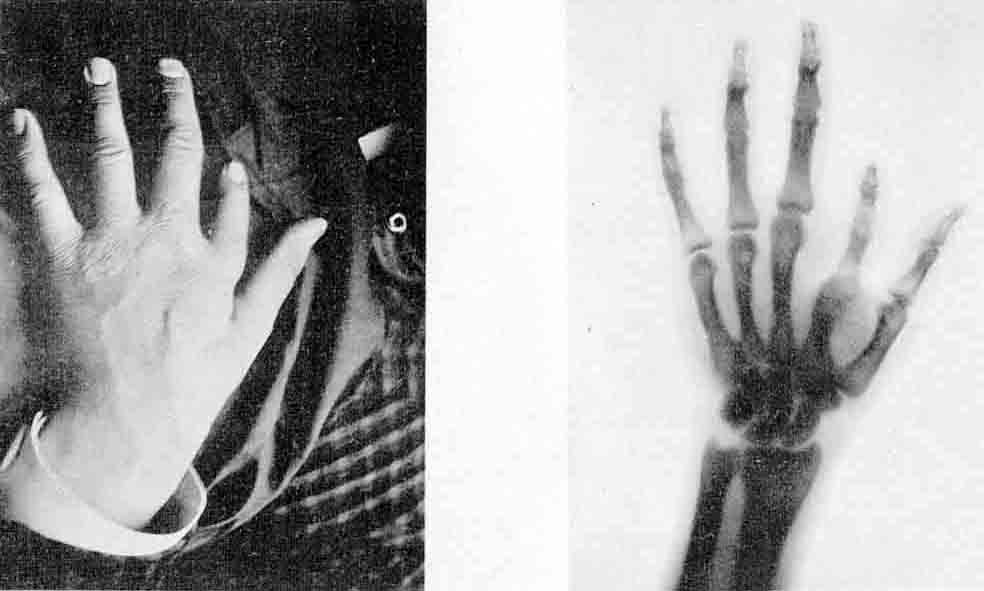Fluorograpy
Fluorograpy is an imaging technology by which the inside of the body can be revealed without the need for invasive surgical procedures. It has been embraced by the medical profession for the examination of broken and fractured bones, and tracing certain types of foreign material inside the body. Its widespread adoption has been hastened due to its success in helping treat injuries in soldiers returning from the Mage War and it remains the primary diagnostic technique for differentiating ironbound patients from shell-shocked ones.
Controversy
The emotional effect on a patient of seeing their own skeleton was profound. Many patients requesting a plate for display at home, remarking that, in the fluorograph, they have seen and accepted their own death. Unfortunately, a small minority came to believe that they had previously died and become ghosts, this belief being most commonly expressed by ironbound war veterans. These unexpected reactions have caused significant debate about fluorography among the upper echelons of the College of Necromancy, with some wanting to use it to promote comfort with personal mortality, and others warning of the harmful psychological and religious aspects of "abbreviating the process of living".Public perception
This religious and philisophical debate has not stopped the appetite of the public for 'living death photograhy', and - filling the void left by the prohibition of amateur mediums and spiritualists - fluorography booths have sprung up at resort towns and funfairs, allowing members of the public to see their own bones in real-time. Efforts to make a fluorographic motion picture have been proposed multiple times but, as of the current date, none have made it to production. Fluorograph of an Ialy hand with underdevleoped primary finger
Discovery
5.876
Jurdan Torrontegui discovered that passing an electical current through a partial vacuum would cause it to fluoresce, noting it as an interesting byproduct of his research into stored electricity. 5.883
Anwas Wynne observed several instances of Torrontegui's fluorescence occurring despite no direct exposure to the source. They discovered that certain materials (paper, canvas, cardboard, and leather) were unable to block the transmission but that some metals were impervious to the effect, and speculated about a subclass of invisible light. 5.897
Professors Annikki and Meeri Hänninen of Kiuri Univeristy, developed the first static fluorograph after noting that sealed photographic plates became exposed in the presence of Torrontegui's fluorescence. Using the fluorescence to make images of household objects succeeded in capturing the bones of Meeri's hand and the frames of the glasses she was holding, indicating the future medical use of fluorograph. Present
The first 'live' fluorograph was produced in 5.901 by Doctor Llʼuqi ut-Tatngúk, who projected images onto a chemically infused screen. She went on to develop the Cryptoscope, the first widly-available fluorographic imager.
Jurdan Torrontegui discovered that passing an electical current through a partial vacuum would cause it to fluoresce, noting it as an interesting byproduct of his research into stored electricity. 5.883
Anwas Wynne observed several instances of Torrontegui's fluorescence occurring despite no direct exposure to the source. They discovered that certain materials (paper, canvas, cardboard, and leather) were unable to block the transmission but that some metals were impervious to the effect, and speculated about a subclass of invisible light. 5.897
Professors Annikki and Meeri Hänninen of Kiuri Univeristy, developed the first static fluorograph after noting that sealed photographic plates became exposed in the presence of Torrontegui's fluorescence. Using the fluorescence to make images of household objects succeeded in capturing the bones of Meeri's hand and the frames of the glasses she was holding, indicating the future medical use of fluorograph. Present
The first 'live' fluorograph was produced in 5.901 by Doctor Llʼuqi ut-Tatngúk, who projected images onto a chemically infused screen. She went on to develop the Cryptoscope, the first widly-available fluorographic imager.
Remove these ads. Join the Worldbuilders Guild




Great idea to write about a medical scan! I love how you talk about the cultural impact it has on people :D